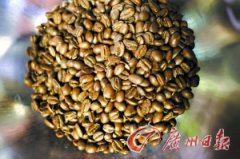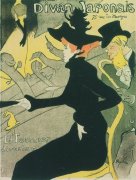Coffee time in Tang and Tang dynasties
Not long ago, Tang Tang's coffee shop advertised "One dollar for black coffee." Several cultivators in the town who usually ate vegetarian food could not resist the temptation and made an appointment to drink. After tasting the heavy mantenin, everyone changed into the soft floral Yejia Xuefei. There are less than 100 baristas with Q-Grader (coffee quality appraiser) qualifications in China, and one of them lives in seclusion in a small town. Everyone feels that they have opened their eyes. Everyone drank happily, and the barista was the happiest."I didn't expect many people to start liking black coffee."
For those who like soft sour taste, Tang Tang brews Ethiopian Yejia Xuefei for him. Use a fine-mouthed pot to pour boiling water vertically into the small hole in the center of the coffee powder. The bubbles slowly rise from the center to the coffee powder plane, turn outward, and pour water in a circular way. Stop when approaching the filter paper. At this time, the coffee powder expands, which is a symbol of fresh coffee beans. Stop stewing for a while, let the coffee powder fully absorb moisture, and then hold the coffee pot and pour water stably from inside to outside.
Tang Tang introduced the relationship between the origin, environmental habits and taste of each coffee while brewing: Yejia Xuefei is produced in a small town full of flowers in Ethiopia. It is the hometown of Arabica coffee. The coffee flower fragrance produced there is full. The barista retains the flower fragrance with medium and light roasting. The better medium and light roasting is often accompanied by soft sour taste.
Coffee gives people a strong "circle" smell, and the preference for a certain coffee vaguely reveals a certain interest in life.
In China, it has been nearly three to five years since people began to like drinking black coffee. "Just like people who liked milk tea when they were young, they like pure tea when they grow up." Tang Tang said that returning to a more gentle and natural roasting and follicular method, removing excess taste stimulation, leaving only the simple taste produced by plants and heat, is the reason why more and more people like black coffee.
British barista James Hoffman defines fine coffee as "the quality score of the green beans and the craftsmanship of the barista". In Tang Tang's view, after coffee harvest, the quality of taste and taste depends largely on the quality of the barista, among which the importance of various abilities is taste, baking skills, brewing.
Tasting power includes the barista's understanding of coffee. In order to properly express the original taste of coffee, the barista needs to adopt different roasting curves according to the characteristics of beans."Just like stir-frying, some dishes are suitable for quick frying, some are suitable for slow cooking on low fire. When the roasting is done, open for a few hours, dissipate the fire, and pack every other day."
Before the system learned coffee tasting, Tang Tang drank coffee simply because he liked coffee. After becoming a coffee taster, because you have to choose coffee from different customers 'perspectives, you can't emphasize personal preferences too much. You have to treat each coffee objectively, know their tonality, and convey the information objectively and accurately to coffee drinkers through roasting and brewing.
The Q-Grader qualification test is extremely difficult. Take taste test as an example. People who aspire to become baristas are required to distinguish three grades including sour, sweet and salty tastes. Taking sour taste discrimination as an example, learners are required to identify organic acids such as acetic acid, phosphoric acid, citric acid and malic acid, while olfactory ability test includes discrimination and definition of 36 odors.
The experience of observing and remembering things through smell is interesting, concrete and mysterious, fleeting. Tang Tang usually trained himself to close his eyes to smell all kinds of smells, fruits, medicines, spices, soil or meals. The taste of the world was rich and subtle, and he needed to review it frequently and define it with words.
Every day at 8:30 to prepare for the opening, taste coffee, see the state of coffee beans that day. The students came around ten o'clock. If there were coffee beans roasted overnight, they would take a cup test. If not, they would start teaching. They would roast coffee beans in the afternoon and leave work at six o'clock on time. This was Tang Tang's daily routine.
Beans in each period of time are different characteristics, Tang Tang every morning from the taste of coffee beans, the better the quality of beans, the shorter the shelf life, good baristas advocate fresh roast. Tang Tang communicates with guests on WeChat to understand the taste requirements before baking. The most recent roast was the day before yesterday. I roasted mantnin and brazil, and made an espresso blend for the customer's coffee shop. The beans were cultivated on the way out. When they reached the customer's hand, the beans were not only fresh, but also almost delicious. It was the best time to taste them.
Important Notice :
前街咖啡 FrontStreet Coffee has moved to new addredd:
FrontStreet Coffee Address: 315,Donghua East Road,GuangZhou
Tel:020 38364473
- Prev

The temptation of Ecuadorian coffee from the equator
Most countries in the world are rich in only one kind of coffee beans, while Ecuador is one of the few countries in the world that can produce both Arabica and Robusta coffee beans. The Ecuadorian Coffee tasting, sponsored by the Consulate of Ecuador in Guangzhou, was recently held at the Art Cafe in the Guangdong Provincial Museum. Organic beans, flowers and fruits, caramel puff
- Next

Japanese Cafe
Japanese Cafe lithographic poster Edward Funier Japan Cafe is a song and dance nightclub in Montmartre where Parisian artists gather. In 1893, the place was redecorated and incorporated into the very fashionable Japanese style and lanterns of the time. In order to attract customers to attend the opening ceremony of the nightclub, cafe owner Edward Funier customized it from Lautrek.
Related
- How did the Salvadoran coffee industry develop in Central America?
- What exactly does the golden cup extraction of coffee mean?
- The Origin of Coffee flower
- [2023 Starbucks World Earth Day] there are more meaningful things besides free Starbucks coffee!
- What kind of coffee is there in Spain? 9 Flavors of Spanish Coffee
- Aromatic African coffee| Kenya's coffee culture and historical production area
- Liberica Coffee Bean knowledge: the characteristics of Liberian Coffee beans of the three original species of Coffee beans
- The origin and formula of Spanish latte introduces the taste characteristics of Bombon coffee in Valencia, Spain.
- How to adjust the solution of over-extracted coffee
- What is the tasting period of coffee beans? What is the period of coffee and beans? How should coffee wake up and raise beans?

